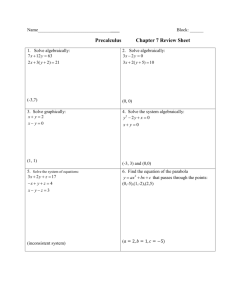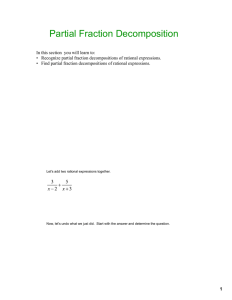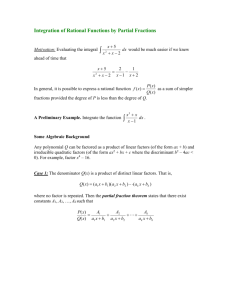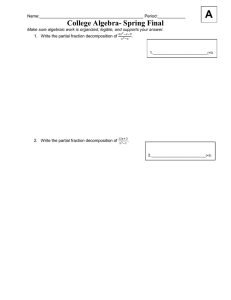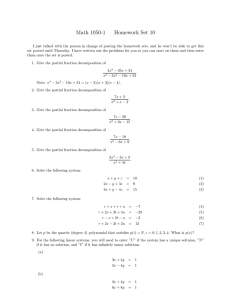The following is an overview of methods involved in finding... tions of rational functions. We will make use of the...
advertisement
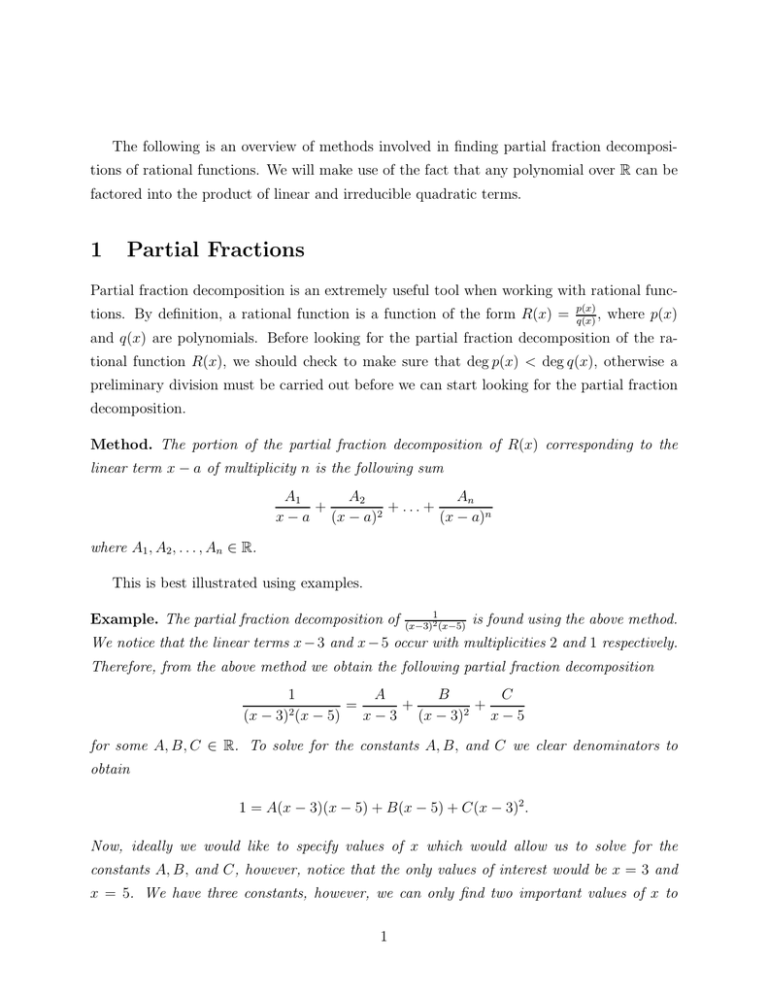
The following is an overview of methods involved in finding partial fraction decompositions of rational functions. We will make use of the fact that any polynomial over R can be factored into the product of linear and irreducible quadratic terms. 1 Partial Fractions Partial fraction decomposition is an extremely useful tool when working with rational functions. By definition, a rational function is a function of the form R(x) = p(x) , q(x) where p(x) and q(x) are polynomials. Before looking for the partial fraction decomposition of the rational function R(x), we should check to make sure that deg p(x) < deg q(x), otherwise a preliminary division must be carried out before we can start looking for the partial fraction decomposition. Method. The portion of the partial fraction decomposition of R(x) corresponding to the linear term x − a of multiplicity n is the following sum A2 An A1 + + . . . + x − a (x − a)2 (x − a)n where A1 , A2 , . . . , An ∈ R. This is best illustrated using examples. Example. The partial fraction decomposition of 1 (x−3)2 (x−5) is found using the above method. We notice that the linear terms x − 3 and x − 5 occur with multiplicities 2 and 1 respectively. Therefore, from the above method we obtain the following partial fraction decomposition A B C 1 = + + 2 2 (x − 3) (x − 5) x − 3 (x − 3) x−5 for some A, B, C ∈ R. To solve for the constants A, B, and C we clear denominators to obtain 1 = A(x − 3)(x − 5) + B(x − 5) + C(x − 3)2 . Now, ideally we would like to specify values of x which would allow us to solve for the constants A, B, and C, however, notice that the only values of interest would be x = 3 and x = 5. We have three constants, however, we can only find two important values of x to 1 substitute, so we know that we will eventually have to equate coefficients. The substitutions of x = 3 and x = 5 into the above equation give B = − 21 and C = 1 4 respectively. To equate coefficients we need to expand the above equation, namely 1 = A(x2 − 8x + 15) + Bx − 5B + C(x2 − 6x + 9) = Ax2 − 8Ax + 15A + Bx − 5B + Cx2 − 6Cx + 9C = (A + C)x2 + (B − 8A − 6C)x + (15A − 5B + 9C). From this we can see that A + C = 0 and since we know C = 1 4 we thus have A = − 14 . Therefore, the partial fraction decomposition we were looking for is 1 − 14 − 21 1 = + + 4 . 2 2 (x − 3) (x − 5) x − 3 (x − 3) x−5 Method. The portion of the partial fraction decomposition of R(x) corresponding to the irreducible quadratic term (x − a)2 + b of multiplicity n is the following sum A2 x + B2 An x + Bn A1 x + B1 + + ...+ 2 2 2 (x − a) + b ((x − a) + b) ((x − a)2 + b)n for some A1 , A2 , . . . , An , B1 , B2 , . . . , Bn ∈ R. Unfortunately, when irreducible quadratics appear in the denominator of R(x), we are forced to equate coefficients when solving for the Ai and Bi . For this reason, in the examples that follow, I will setup the candidate for the partial fraction decomposition, however, I will not solve for the necessary constants. Example. The partial fraction decomposition of R(x) = x (x2 +1)(x2 +5)3 is found using the above method. Notice that the terms in the denominator are indeed irreducible where x2 + 1 and x2 + 5 occur with multiplicities 1 and 3 respectively. Therefore, the above method says that the partial fraction decomposition will have the following form (x2 x A1 x + B1 A2 x + B2 A3 x + B3 A4 x + B4 = + + 2 + 2 2 3 + 1)(x + 5) x2 + 1 x2 + 5 (x + 5)2 (x + 5)3 for some constants A1 , A2 , A3 , A4 , B1 , B2 , B3 , B4 ∈ R. The following will consist of examples of partial fraction decompositions where the details are left to the reader. 2 Example. The partial fraction decomposition for x2 +x+1 (3x+1)2 (x2 +2) is A B Cx + D x2 + x + 1 = + + 2 2 2 2 (3x + 1) (x + 2) 3x + 1 (3x + 1) x +2 Example. In order to find the partial fraction decomposition of the rational function 2x2 +1 x+5 2 a preliminary division must be carried out before applying the above methods because deg(2x + 1) > deg(x + 5). Example. The partial fraction decomposition for x (x − 1)3 (x2 + 1)3 = x (x−1)3 (x2 +1)3 is A B C Dx + E Fx + G Hx + I + + + 2 + 2 + 2 . 2 3 2 x − 1 (x − 1) (x − 1) x +1 (x + 1) (x + 1)3 Example. In order to find the partial fraction decomposition of the rational function x (x2 +2x+2)2 we must first complete the square on the bottom to find a and b such that x2 + 2x + 2 = (x − a)2 + b. Completing the square we see that x2 + 2x + 2 = (x + 1)2 + 1, therefore the partial fraction decomposition is (x2 x x = 2 + 2x + 2) ((x + 1)2 + 1)2 Ax + B Cx + D = + 2 (x + 1) + 1 ((x + 1)2 + 1)2 3
